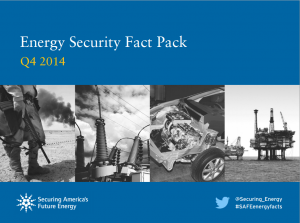Full Title: Energy Security Fact Pact: Q4 2014
Author(s): Securing America's Future Energy (SAFE)
Publisher(s): Securing America's Future Energy (SAFE)
Publication Date: February 1, 2015
Full Text: Download Resource
Description (excerpt):
This edition of the Energy Security Fact Pack investigates several developing trends in domestic and international oil markets, such as falling oil prices, alternative fuel vehicle sales, and global supply and demand fundamentals. This release examines current oil market dynamics and the effect lower oil prices are having on industry valuation and capital expenditures, in addition to U.S. rig counts and oil production.
In addition to updates on the state of the global oil market, the Fact Pack contains a host of new data on electric vehicle market penetration and sales, refueling infrastructure, and broader trends in overall fuel economy.
Global oil prices continued to fall in Q4, ending the year at $55 per barrel (bbl) (Brent), less than half their mid-June highs. Notably, and despite dissension from some members, OPEC’s November 27 meeting saw the cartel maintain production levels. Although prices have since declined below $50/bbl (in mid-January), and the death of King Abdullah of Saudi Arabia briefly generated speculation that the kingdom’s oil policy might shift, the commitment appears robust.
Nevertheless, lower oil prices are affecting governments, oil companies, and other market participants worldwide. For example, Iraq’s total revenues were approximately 30 percent lower in December 2014 than they were in the summer despite production reaching a 35-year high. Moreover, several major international oil companies have announced cuts in capital expenditures for 2015, and while overall U.S. oil production growth is still expected to remain positive this year, the rig count (reflective at least in the short term of exploration and development rather than production) has fallen approximately 22 percent since the end of November.
Oil price volatility (49 percent annualized monthly in December vs. 16 percent January to June) has returned to levels not seen since 2008/9, but lower prices helped U.S. consumers reduce spending on petroleum fuels by 9 percent quarter-over-quarter (q-o-q) in Q4.
